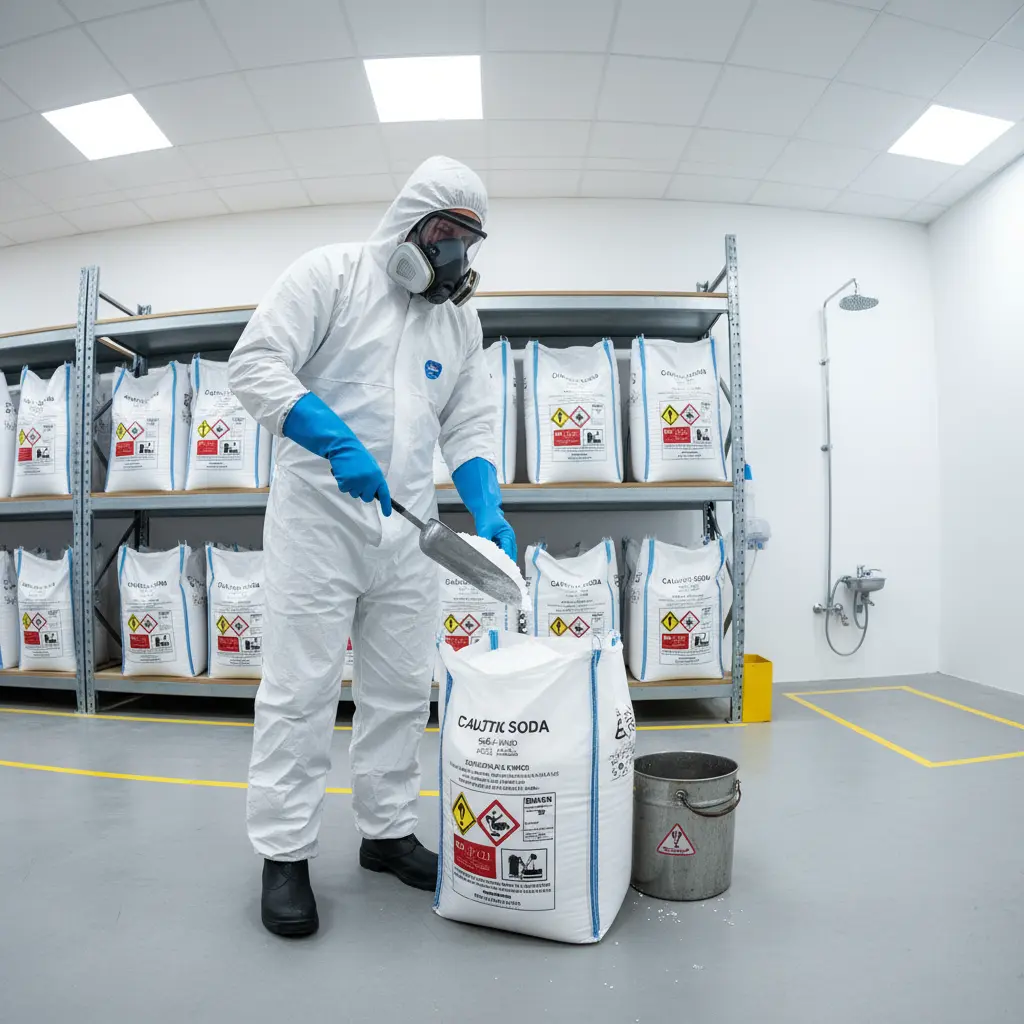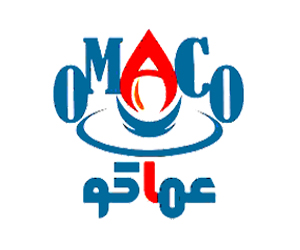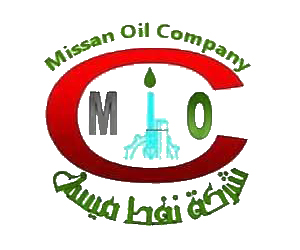
Safe Handling of Caustic Soda: The Comprehensive and Ultimate Guide for Importers and Manufacturers
Date Published: 16/09/2025
Last Updated: 16/09/2025
Author: RastaKimiya - Strategic Expert in Chemical Safety & Industrial Process Optimization.
Safe Handling of Caustic Soda: The Comprehensive and Ultimate Guide for Importers and Manufacturers
The safe handling of caustic soda is a cornerstone of the chemical and manufacturing industries. Mastering safety procedures is not just a regulatory obligation but a strategic necessity to protect lives and assets. This powerful chemical, despite its immense utility, requires strict protocols to prevent catastrophic accidents.
Operational Definition: "The safe handling of caustic soda is a systematic set of engineering and administrative protocols designed to minimize the risks of exposure to sodium hydroxide throughout its lifecycle, from import and transport to storage, use, and disposal."
Preliminary Analysis: The Importance and Inherent Risks of Caustic Soda
Caustic soda flakes (NaOH), or chemically known as "sodium hydroxide," is an essential alkaline substance in various industries. It is used in the production of paper, textiles, soaps and detergents, and even in food processing. According to Grand View Research, the global sodium hydroxide market size is expected to reach USD 59.32 billion by 2027, reflecting its growing industrial importance.
However, the very chemical properties that make it effective are also the source of its danger. Caustic soda is classified as a highly hazardous Class 8 corrosive material. It can cause deep chemical burns upon contact with the skin or eyes, permanent damage to the respiratory system upon inhalation of its dust, and it reacts violently with water in a highly exothermic process.
Risks of Caustic Soda: An Analysis of Causes and Effects
To understand the safe handling of caustic soda, one must first deconstruct the associated risks. The risks can be classified into three main categories: health, environmental, and operational. Familiarity with these risks is the first step toward effectively implementing precautions for using sodium hydroxide.
Direct Health Risks and Biochemical Analysis
The most prominent risk is direct contact. Sodium hydroxide reacts with fats and amides in living tissues through a process called saponification, leading to tissue necrosis and liquefaction. This causes deeper and more painful burns than acid burns, which cause coagulation necrosis, creating a protective layer that prevents deeper penetration.
- Skin: Causes chemical burns that can be as severe as third-degree. The exothermic reaction with skin moisture intensifies the injury.
- Eyes: Sodium hydroxide is considered one of the most dangerous substances to the eye. It can cause corneal opacity, glaucoma, and permanent blindness even at low concentrations.
- Inhalation: Inhaling dust from caustic soda flakes leads to severe irritation of the respiratory system. It may cause bronchospasm, pulmonary edema, and Reactive Airways Dysfunction Syndrome (RADS).
- Ingestion: A medical emergency that causes severe burns to the mouth, esophagus, and stomach. It can lead to perforation of the esophagus or stomach, which can be fatal.
Advanced Environmental and Operational Risks
The strong reaction of caustic soda with water generates intense heat (Enthalpy of solution ≈ -44.5 kJ/mol). This energy can cause the solution to boil and splatter violently. Furthermore, its reaction with some amphoteric metals like aluminum, zinc, and tin releases highly flammable hydrogen gas, creating an explosion hazard in enclosed spaces. Improper storage of caustic soda flakes multiplies these risks.
On an environmental level, a large spill can significantly alter the pH of water bodies and soil, harming aquatic life and vegetation. Although sodium and hydroxide ions are common in the environment, the sudden and concentrated change in pH is the primary source of damage.
The Systematic Framework: The T-S-U Model for Safe Handling of Caustic Soda
To organize the safety process, we propose a three-dimensional conceptual model (T-S-U): Transport, Storage, and Use. This framework covers all potential points of contact and provides a clear structure for applying engineering and administrative controls. Understanding this model is essential for proactively managing the risks of caustic soda.
| Phase (T-S-U) | Primary Objective | Engineering Controls | Administrative Controls | Personal Protective Equipment (PPE) |
|---|---|---|---|---|
| Transport | Prevent leaks, contamination, and ensure shipment safety | UN-rated containers, protective liners, cargo securing systems | Driver training (HAZMAT), correct shipping documents (SDS/MSDS), emergency response plan | Emergency spill response kit |
| Storage | Isolation, environmental control, and prevention of hazardous reactions | Dry, well-ventilated areas, away from incompatible materials, secondary containment bunds | Clear warning signs (GHS), inventory tracking system (FIFO), periodic inspections | Eyewash stations and safety showers in strategic locations |
| Use | Minimize direct exposure and prevent operational accidents | Local exhaust ventilation (LEV), closed mixing systems, automated dosing systems | Standard Operating Procedures (SOPs), work permits, task-specific training | Chemical splash goggles, gloves (nitrile/neoprene), chemical-resistant suit |
Model Assumptions and Limitations
This model assumes the facility has a basic safety infrastructure and adheres to local regulations. Its success depends on strict adherence to continuous training and periodic reviews. Highly specialized industries, such as semiconductor manufacturing, may require additional controls beyond this general framework. Furthermore, the model does not directly cover the final waste disposal phase, which requires separate protocols.
Implementation Strategies and Scenarios: From Theory to Practice
The implementation of safe handling of caustic soda must be practical and systematic. This involves clear steps from planning to emergency response. Understanding these strategies is an integral part of comprehensive HAZMAT Management.
Safe Transport and Unloading Strategy
The transport of caustic soda is one of the riskiest phases due to the potential for road accidents. It must be ensured that trucks carry the correct dangerous goods placards (UN 1823) and that drivers are trained to handle initial spills. During unloading, the area must be secured, and access by unauthorized personnel must be prevented.
To ensure compliance, local and international regulations must be continuously reviewed. The ADR Agreement provides an excellent reference framework for Europe, while the U.S. Department of Transportation (DOT) sets the regulations in the United States. Within your company, you can create internal shipping protocols for hazardous chemicals to standardize procedures.
Storage Protocol for Caustic Soda Flakes: Engineering and Administrative Details
A specific area must be designated for the storage of caustic soda flakes. This area should be cool, dry, and well-ventilated, away from direct sunlight and sources of moisture. These precautions significantly reduce the risks of caustic soda related to chemical reactions.
- Physical Separation: Sodium hydroxide must be stored away from acids (violent neutralization reaction), organic solvents, and reactive metals (like aluminum). Maintain a minimum distance of 3 meters between them.
- Container Integrity: Bags or drums must be intact and tightly sealed to prevent dust leakage. Use a "First-In, First-Out" (FIFO) system to prevent the product from hardening over time due to absorption of moisture and carbon dioxide from the air.
- Engineering Infrastructure: Floors should be corrosion-resistant and sloped towards a collection sump. The storage area must have a secondary containment system capable of holding 110% of the volume of the largest container.
- Administrative Controls: Install clear signs following the Globally Harmonized System (GHS). Inventory lists must be up-to-date and available to emergency response teams.
Essential Checklist for Using Sodium Hydroxide and Handling Solutions
When preparing for use, follow this checklist to ensure maximum safety. Wearing personal protective equipment for caustic soda is a non-negotiable step in any process involving this substance.
- Prepare the Work Area: Ensure Local Exhaust Ventilation (LEV) systems are operational and emergency response equipment (neutral absorbents like sand or vermiculite) is available.
- Wear Full PPE: Never start work without full personal protective equipment for caustic soda. This includes chemical splash goggles with a face shield, chemical-resistant gloves (e.g., neoprene or PVC), and an apron or suit made of Tychem® material.
- Safe Mixing Protocol: When preparing solutions, slowly and gradually add the caustic soda to cold water, never the other way around (remember the AAA rule: Always Add Acid/Alkali to water). Use a heat- and corrosion-resistant mixing vessel (like stainless steel or high-density polyethylene) and stir continuously to distribute the heat.
- Immediate Cleanup: Clean up any spills immediately. For solid spills, cover them with an inert absorbent, then carefully collect them in a designated container. For liquid spills, contain them and then neutralize them with a weak acid (like dilute acetic acid) before final cleanup.
Emergency Response Plan: Preparing for the Unexpected
The best safety plans include clear protocols for emergency response. Every employee must know their role in the event of an incident. The response plan should be written, accessible, and regularly drilled.
Key elements of a response plan include: incident reporting methods, evacuation procedures, locations of emergency equipment (fire extinguishers, eyewash stations, spill containment kits), and contact numbers for local emergency services and the HAZMAT team. The Occupational Safety and Health Administration (OSHA) provides excellent resources for developing these plans.
Conclusion and Future Outlook: Towards a Zero-Accident Workplace
Mastering the safe handling of caustic soda is not an option; it is the foundation of business continuity and human capital protection. By implementing the systematic T-S-U model and its engineering and administrative details, importers and manufacturers can transform the inherent risks of sodium hydroxide into fully controllable processes. A commitment to continuous training and protocol review ensures a strong, embedded safety culture.
The future requires adopting modern technologies such as IoT remote monitoring for storage areas, gas sensors, and automated mixing systems to minimize human intervention. Investing in safety today is an investment in the company's efficiency and reputation tomorrow.
Call to Action (CTA): To ensure your facility's safety and compliance with international standards, invest in training your team and updating your safety protocols today. Contact us for a specialized consultation on the best practices for the safe handling of caustic soda, tailored to your operations.
Frequently Asked Questions about Safe Handling of Sodium Hydroxide (FAQ)
What should you do if caustic soda touches the skin?
Immediately remove contaminated clothing and wash the affected area with plenty of running water for at least 15-20 minutes. Afterward, seek immediate medical attention and do not attempt to use any creams or ointments.
How to transport caustic soda safely?
Caustic soda is transported safely by using approved, corrosion-resistant containers with appropriate hazard placards (UN 1823). Drivers must be trained in emergency procedures, and a Material Safety Data Sheet (MSDS) must be provided with every shipment.
What is the correct way to store sodium hydroxide?
Sodium hydroxide should be stored in a cool, dry, and well-ventilated area, away from incompatible materials like acids and metals. Containers must be tightly sealed and made of resistant materials such as carbon steel or polypropylene.
What is the first aid for caustic soda burns in the eye?
Immediately flush the affected eye with a gentle stream of water for at least 30 minutes, keeping the eyelids open. Water should be directed from the inner corner of the eye to the outer to prevent contamination of the other eye, then seek emergency medical help immediately.
Where can I find the Material Safety Data Sheet (MSDS) for sodium hydroxide?
The supplier or manufacturer must provide a Safety Data Sheet (SDS/MSDS) with every shipment of sodium hydroxide. It can also be found online by searching for "Sodium Hydroxide SDS" along with the manufacturer's name.






